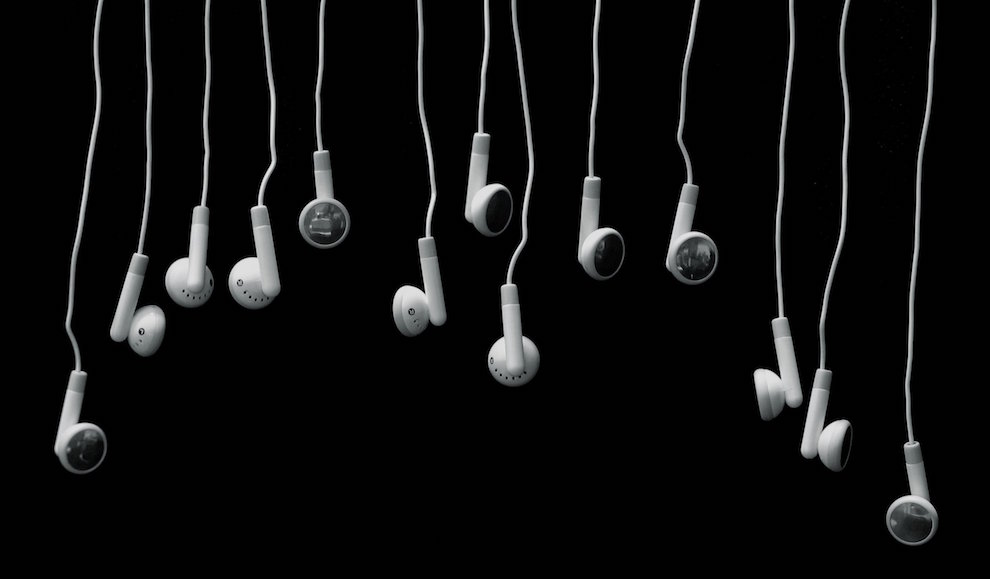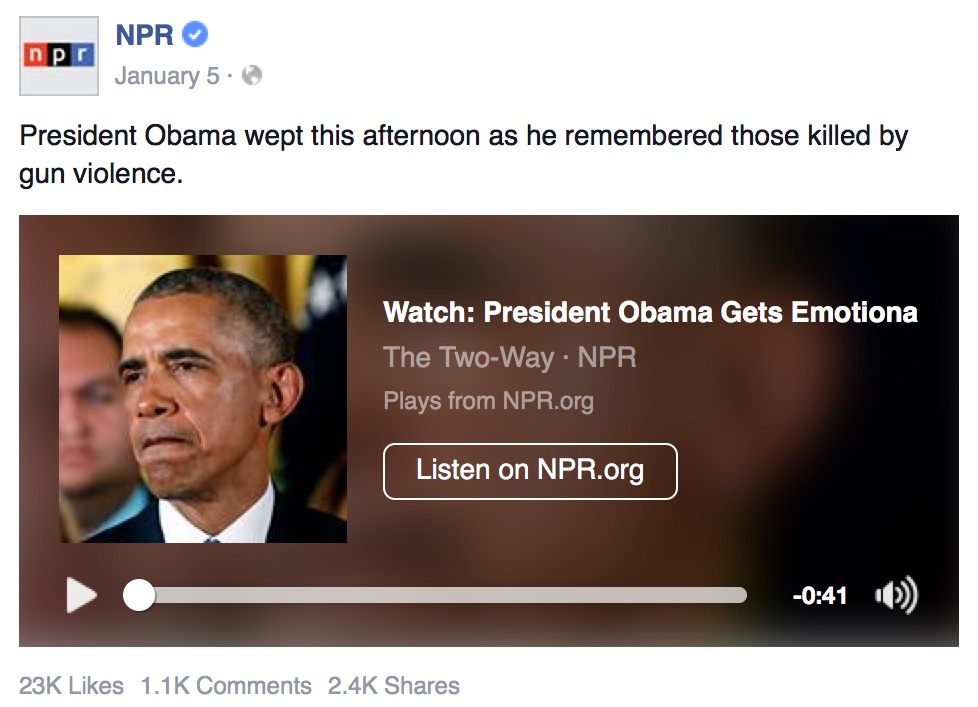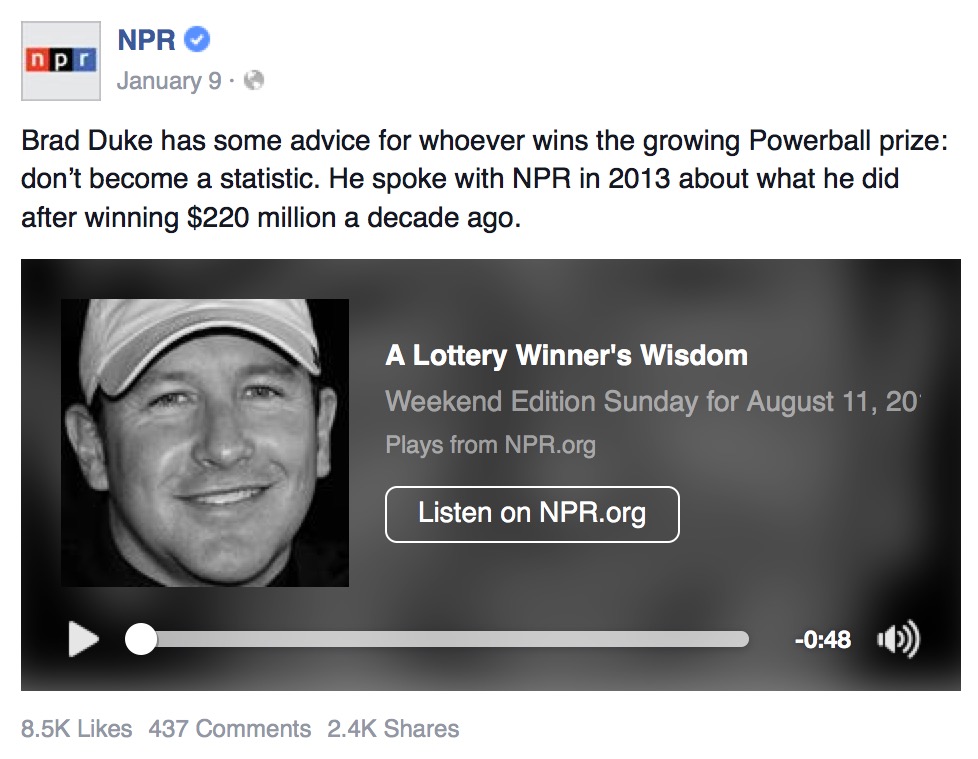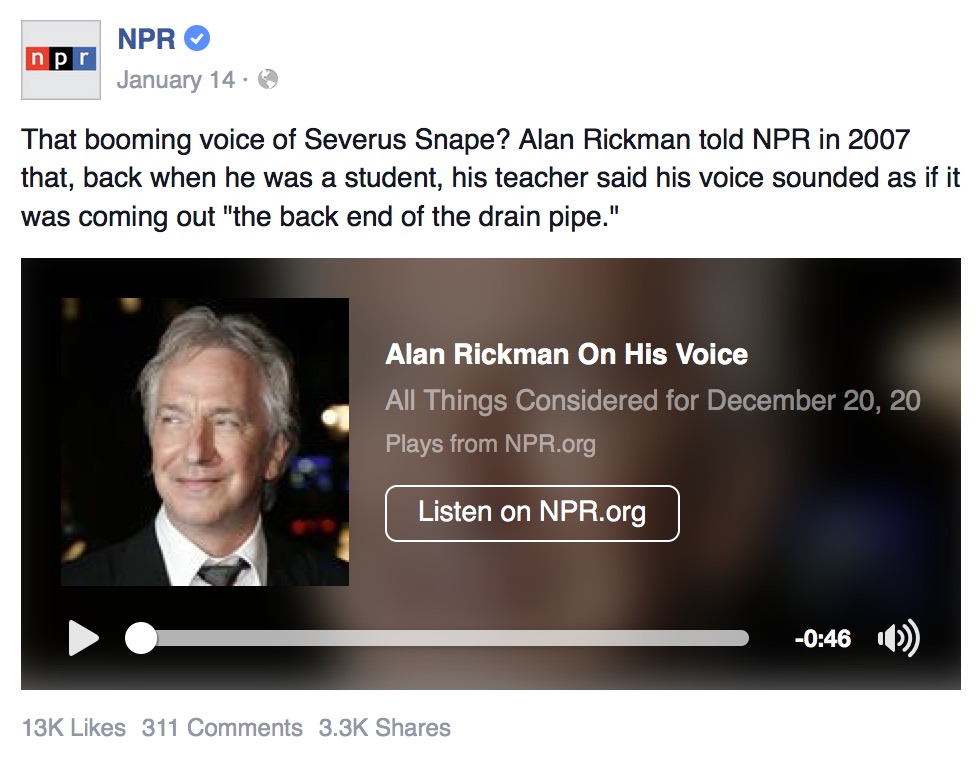
But social audio has huge potential for audio creators and podcasters who produce hours of great content every day but still struggle with discovery and reaching new audiences. At NPR, we recently tried a different approach with a beta Facebook audio player. Spoiler alert: We didn’t find the winning formula to make audio go viral — but we did learn a few things about the type of clip and packaging that works well in such a space.

Facebook’s new inline audio player was originally designed for music services like Spotify and Apple Music. With a couple of tweaks, Facebook adapted the player for editorial use by NPR and Serial in a month-long pilot earlier this year.
I ran the editorial side of the experiment for NPR, during which my full-time job revolved around searching for the best audio clips from our big news shows and podcasts. The entire newsroom was invited to participate and helped by pitching suggestions. (It was tremendously helpful — I panicked initially at the thought of listening to 30-plus hours of radio on my own each week.)
Building on lessons from previous NPR experiments with social audio, I strove for variety, trying to collect clips that ranged from a few seconds to five minutes, from news magazines and from podcasts, from interviews and features to breaking news and archival content. After I picked a clip, the workflow was fairly convoluted and involved juggling our audio editor, content management system, and Facebook’s debugger.Before you tweet at me asking for in-depth success metrics, keep in mind that this was an experiment with a limited sample size (52 clips total). We had the standard Facebook numbers for reach and engagement, but were not able to get data on play counts and listening duration. The following conclusions aren’t based on a deep scientific analysis, but they’re nonetheless illuminating.
Despite the complicated workflow and other challenges (detailed further down), I did learn a lot about the types of audio content Facebook users wanted to engage with.
In some cases, we had great luck with quick-turnaround content.

During President Obama’s January address on gun control, he became emotional and started to cry. They were the tears seen around the Internet. Shortly after the speech, we isolated that powerful moment and turned it into an audio post with a very short teaser to set it up. The clip itself linked to a Two-Way blog post, allowing us to share it hours before the same thing aired on All Things Considered. It reached over 2 million Facebook users and was our second most popular clip during the experiment.
It seems obvious, but clips that are best experienced by listening were a clear choice for the audio posts. The best performer in that category was an outtake from this hilarious interview with comedian Jon Benjamin where he talked about recording a jazz album, despite knowing nothing about jazz (unfortunately the Facebook clip no longer works).
NPR’s tremendous archive is one of its greatest assets — and that certainly proved to be true with the following clips, all of which were among our most popular posts during the experiment. True, they were compelling pieces of audio, but more than that they were zeitgeist-y topics of the moment.

We posted this clip from an archival interview with a lottery winner at the height of Powerball fever. It was shared widely and drove more than 250,000 people to click through to the full story on NPR.org, making it the most popular clip we tested.

There was perhaps no more perfect a clip to eulogize Alan Rickman than this one from an All Things Considered interview in 2007 in which he talked about his iconic voice (and the criticism he received for it early on). The audio post was widely shared; we had similar success with an excerpt of David Bowie from Fresh Air. Obituaries always provide an opportunity to leverage our vast archive, and this experiment made clear that Facebook audio clips are particularly well suited for that material.
Although metrics-wise the Facebook audio posts generally underperformed relative to our normal story posts, they actually presented a new opportunity for some pages we wouldn’t have otherwise promoted on social media.
If you’ve ever looked at the Morning Edition rundown, for example, you’ve noticed that many of the stories are summary-only, with minimal text and no images. We don’t often share these pages on social because they’re kind of ugly, and who really wants to read a transcript? The Facebook audio posts made it much easier to surface that still-great audio content.

This Car Talk example was a perfect case study. It was a fun moment between the beloved Ray Magliozzi and Robert Siegel that few digital users would have discovered otherwise.
Outside of content type, there were a few other lessons:
In addition to providing some clues about content type and approach for future social audio projects, this experiment also crystallized some of the known challenges of trying to share audio.
For one, spoken-word audio is difficult to multitask with if you’re reading or browsing other things. A user may also not be in the mood or position to listen (at work, no headphones, etc). And they may not even be building the listening habit, thanks to the proliferation of silent autoplaying videos with captions. While we saw some anecdotal evidence in comments and private messages that some users appreciated the player, it was also clear that many were pulling the classic “comment before listening/reading/watching” move.
From an audio producer’s perspective, it’s hard to isolate a great moment and set it up with grabby context when you’re asking someone to click into it “cold.” This is related to another challenge — it’s difficult in general to sell a listening experience in the wordy/visual marketplace that is the Internet: “Trust me, this is really, really great even though you don’t know who’s talking and there’s nothing to look at and I’m asking you to focus for 40 seconds!”
The Facebook tool also doesn’t try to solve other big technical problems with sharing audio. It’s hard for listeners to clip and share their own favorite audio moments from radio or podcasts, especially when much of that listening happens in discrete podcasting apps. And although SoundCloud may be the closest thing we have to a “YouTube for audio,” no tool has been adopted universally across all social platforms.
At NPR we are continuing to explore the challenge of social audio beyond this experiment. We recently launched a new player for NPR.org and a web app for NPR One. We’re also excited about all of the other projects in the social audio sphere, including WNYC’s “audiograms.”
Serri Graslie is a member of NPR’s Editorial Training team.